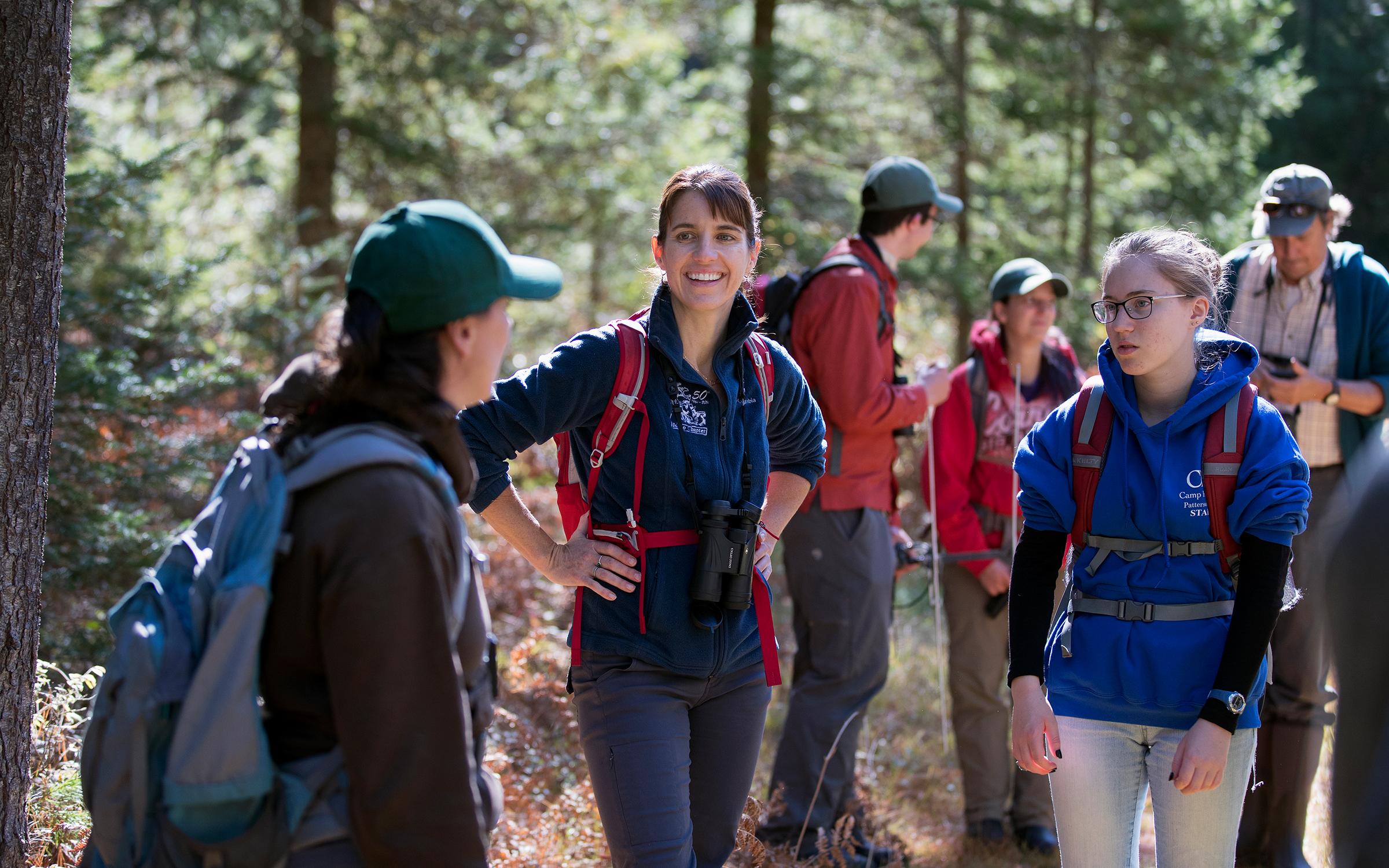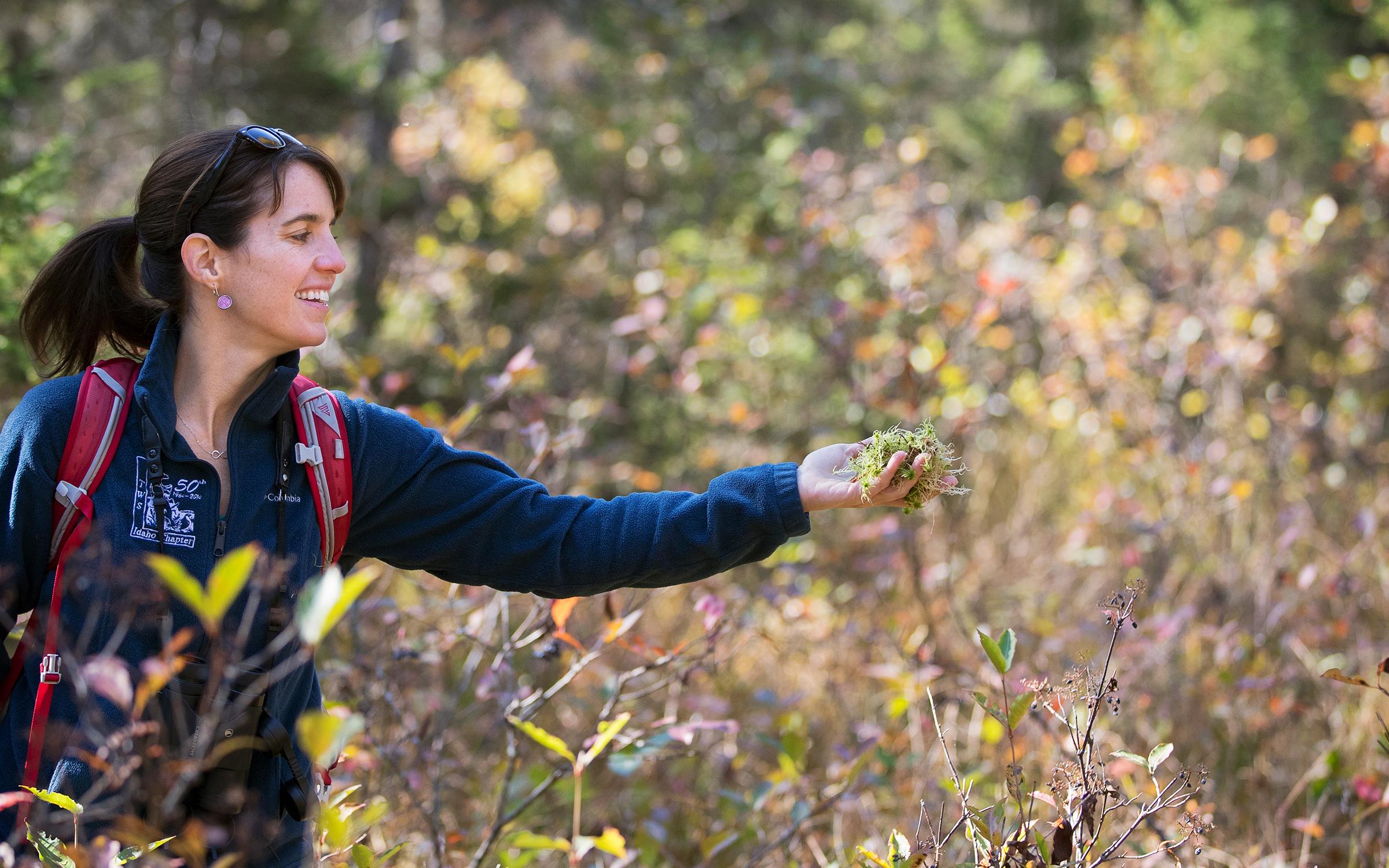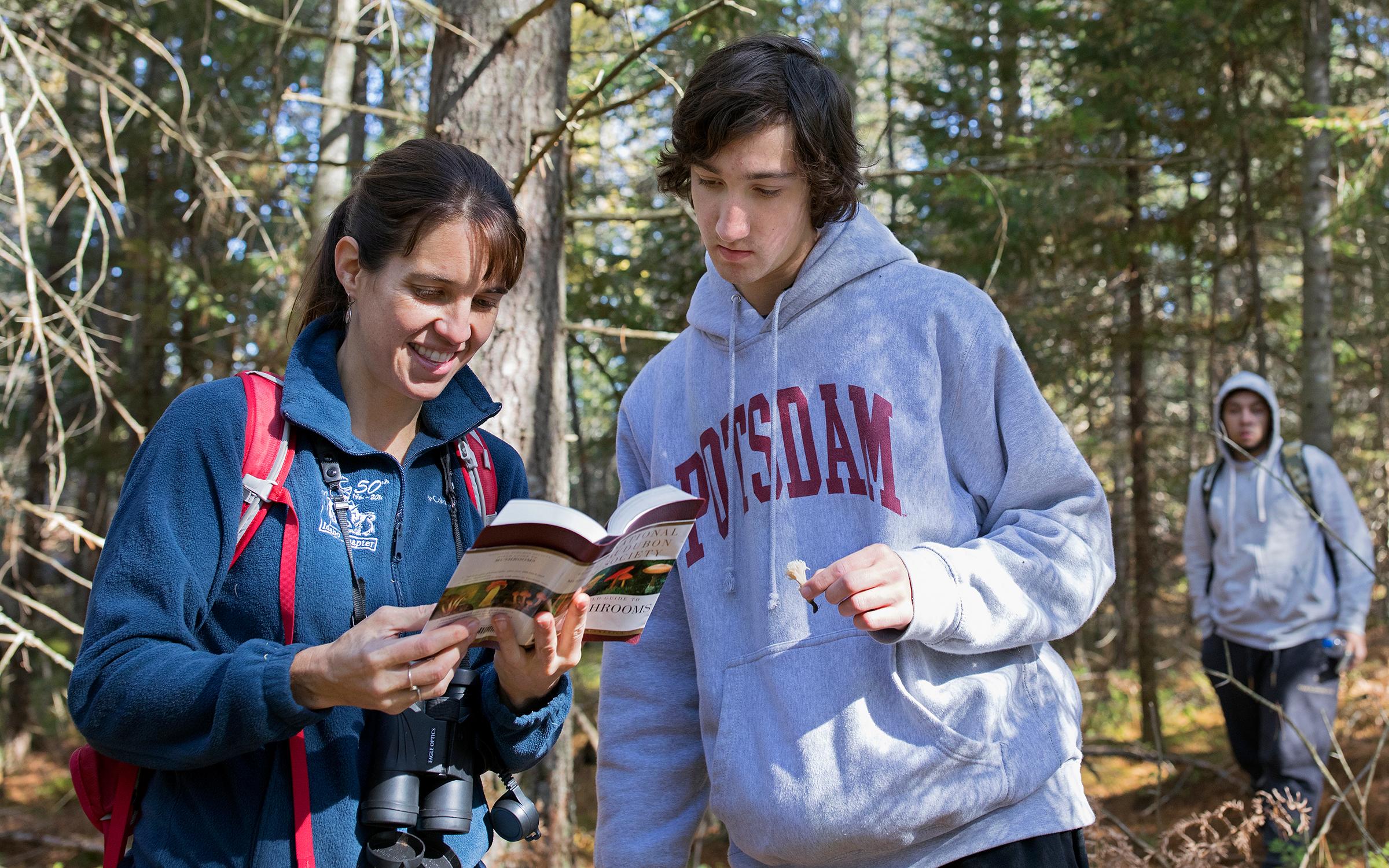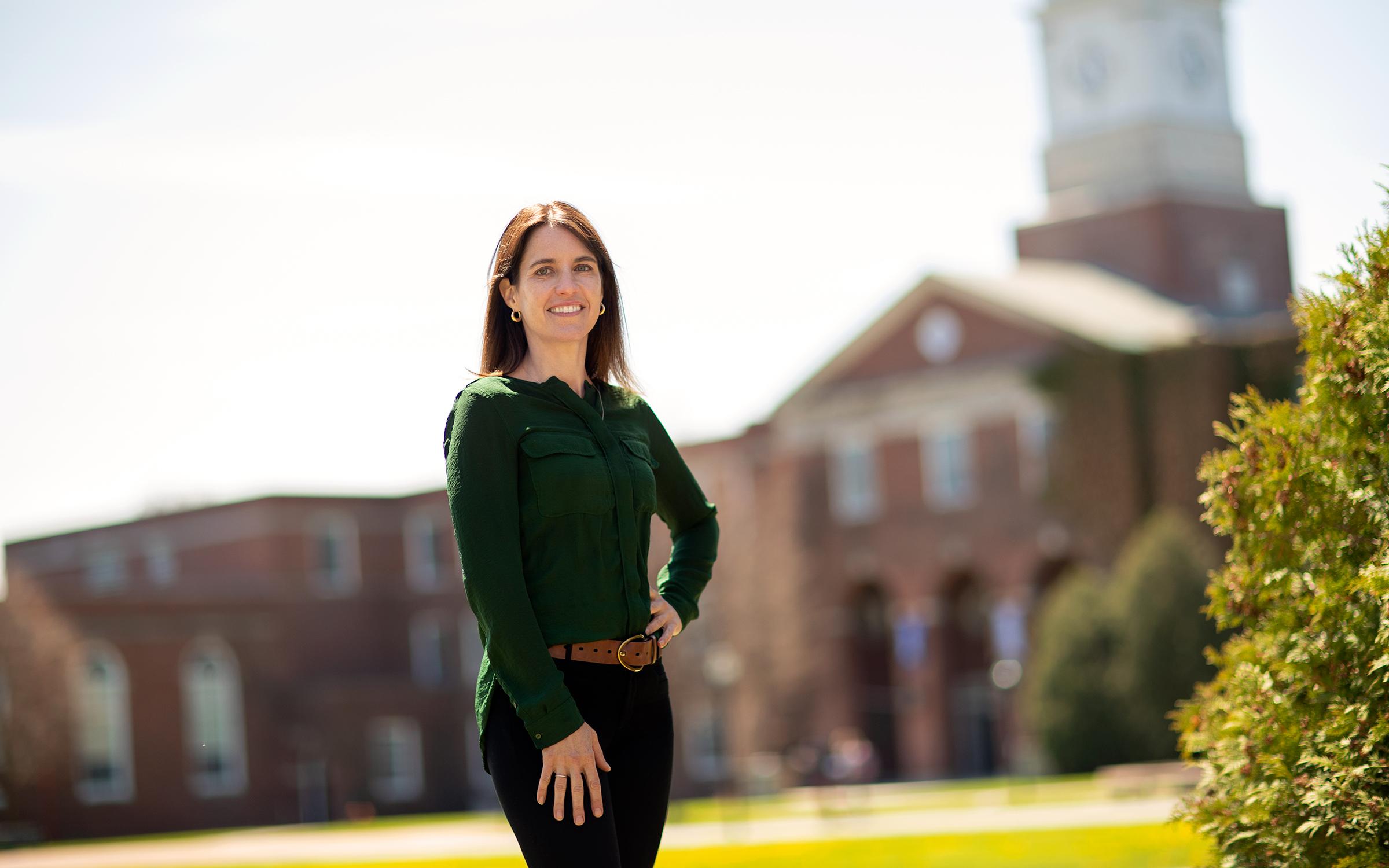As night falls, and the bats rise from their slumber, Dr. Kate Cleary and her students hop in a car to conduct research along the winding roads through Northern New York—their makeshift lab where they capture the clicking sounds of bats on an acoustic monitor mounted to the roof.
“I really love doing research with my students. We drive around these transects and then analyze the data. It’s like the Batmobile,” Cleary said. “My research is very applied. You might need to be in on the computer for some of it, but you cannot be a good conservation biologist without getting out in the field.”
Like a census taker for winged mammals, Cleary started monitoring bats with her students in the summer of 2020, cataloging data about their population numbers, and how white nose syndrome has negatively impacted the species—a fungus that Cleary said has killed millions of bats in the United States and had a significant economic impact on agriculture with the lack of pest control.

Kate Cleary works with students in the field during the Environmental Studies Adirondack Experience, a unique program that allows first-year students to work with the same group of classmates as they take English, Adirondack ecology, and environmental studies courses throughout the semester.
Looking at six sample areas in St. Lawrence County, they monitored bats in the region with equipment purchased through a Kilmer grant from Lougheed Center for Applied Learning. As Cleary continues to collect data with her students in the future, it will be shared with the U.S. Geological Survey’s North American Bat Monitoring Program, a piece of a larger puzzle that reveals how their population numbers are changing.
“Dr. Cleary is by far one of the most influential professors at Potsdam. I always love being in her classes. It was an amazing opportunity to participate in research and explore the North Country in the Batmobile.”
-Zoey Fiber ’22
An associate professor in the Department of Environment and Sustainability, and a PRODiG faculty member, Cleary brings years of experience, steeped in hands-on international research, into the classroom. In 2007, she enrolled in a unique program at Colorado State University that allowed her to enter the Peace Corps while also pursuing a graduate degree in biology. For two and a half years, she worked in a high-altitude forest in Guatemala where she created a biological inventory of the bird species, and learned about the balance between land conservation and land use.
“These lands are well protected by the Mayan K'iche' people, but they also extract firewood, and graze their animals there, but they regulate it themselves, as they had for thousands of years. When you look at aerial footage, it’s one of the most well-protected forests in Guatemala, which is a pretty strong testament to the power of indigenous groups to protect their own land,” she said.
In 2010, Cleary discovered another joint program through the National Science Foundation that allowed her to pursue a fully-funded Ph.D. at the University of Idaho, while simultaneously receiving funding for a research project at CATIE (Centro Agronómico Tropical de Investigación y Enseñanza) in Costa Rica. “That program is part of the reason that I’m in environmental studies, because it basically addressed this need for more interdisciplinary scientists,” Cleary said.

Kate Cleary explores the Adirondacks, a beautiful state park just a short drive from campus.
As one of 24 graduate students in the program, she studied the biological corridor between Braulio Carrillo National Park in Costa Rica, and the Indio Maíz Biological Reserve in Nicaragua. It was there that Cleary first started her research on bat species, examining their movement within the corridor, and studying how human influences, and the rise of pineapple plantations, had affected their habitat.
“It was an amazing experience. I was trying to see how connected bat populations were across the landscape, and we chose bats because they disperse the seeds of more than 500 tropical plants,” Cleary explained. “I used genetic approaches, and I was able to say that the larger bats were able to fly across the landscape, breed, and pass their genes with no problem, but the smaller bats were showing genetic isolation and inbreeding in some of the forest patches surrounded by pineapples.”
After three years of funding through the program, she received a Fulbright Scholarship in 2013 to finish her research and Ph.D. as she continued to uncover clues about how land use was affecting wildlife in Costa Rica. “What I found, roughly, is that if you have no more than 500 meters of pineapple, those little bats can still get across that area,” she said. “We were able to provide recommendations to the National Platform for Responsible Pineapple Production and Trade, which was putting together a report to make pineapple more sustainable. It was really rewarding to have the research actually go somewhere.”

Kate Cleary looks at a field guide with Riley Notarthomas '23 while explores the Adirondacks.
Her passion for studying bat populations continues at SUNY Potsdam today. Since joining the environment and sustainability faculty in 2019, she has emphasized hands-on learning for her students, and given them opportunities to study plants and animals in the field. In the summer of 2021, through the Walker Fellowship, she conducted research with her students to examine the effectiveness of bats to control populations of insects that are known crop pests at Kent Family Growers in Lisbon, N.Y. At the end of the summer, her team noticed a strong correlation between the prevalence of moths, and the presence of bats around the farm. “We found that when the Western Bean Cutworms population peaked, the bats activity also peaked, it was a mirror of their activity. The bats are definitely out there helping control these pests,” she said.
In addition to her research on bats, Cleary continues to collaborate with students on data collection around the region, including the Adirondack Inventory Monitoring Project, where they have been using camera traps to record wildlife in Potsdam’s Lehman Park. Funded by the Lougheed Center for Applied Learning’s Kilmer Lab program, which supports faculty-led research with students, Cleary has been able to purchase the equipment needed for the project.
“Glenn Johnson and I are participating in this project, and this is another time where I’m collecting data locally, but it’s going into a larger database,” she said. “This is going to be an ongoing project, we’re going to have these camera traps up, we’re going to be consistently collecting data, so I thought this could be a Kilmer Lab. They were able to support me with buying SD cards for the cameras, batteries, and the acoustic monitor microphone that I needed. I have a new student starting in the fall.”

Kate Cleary poses for a portrait overlooking SUNY Potsdam's Satterlee Hall.
Tom Baker, the associate director of Lougheed Center for Applied Learning, oversees the program. “Kilmer Labs helps fund projects that include mentorship of undergraduates as research assistants,” he said. “Dr. Cleary’s work shows how a minimal outlay of donor funds can be a catalyst for a robust program of learning and research for students and faculty.”
As she wraps up her third year at the College, Cleary reflects on her role as an educator at the College. “I really love teaching, interacting, and doing research with my students, and seeing them grow from freshman to senior year,” she said. “My favorite part of teaching is that no matter what kind of mood I’m in, when I go into the classroom, the students cheer me up. There’s always something to laugh about, and I always come out feeling better than when I went in. That’s what makes me love this job.”
Article and photos by Jason Hunter
